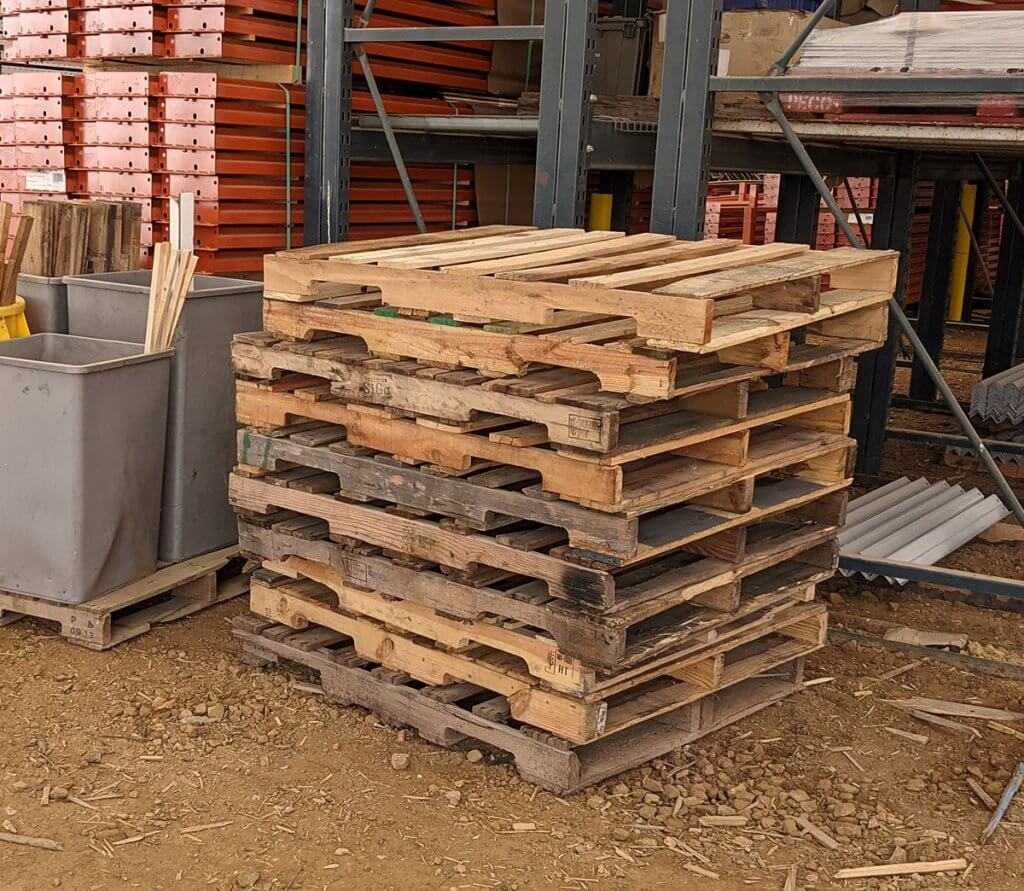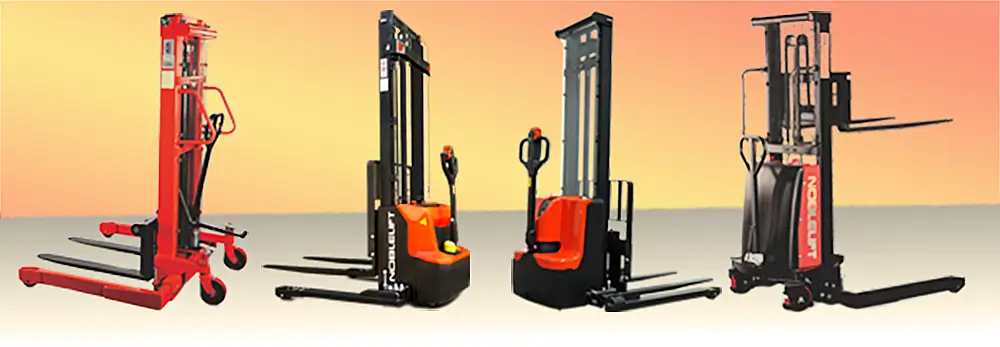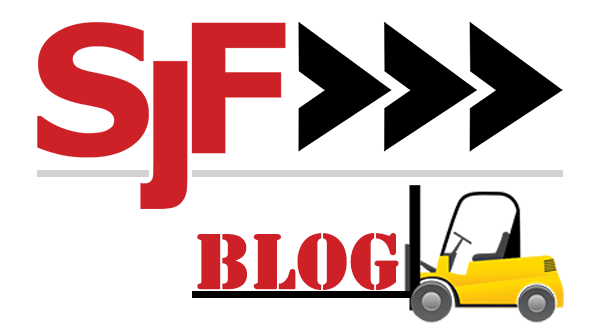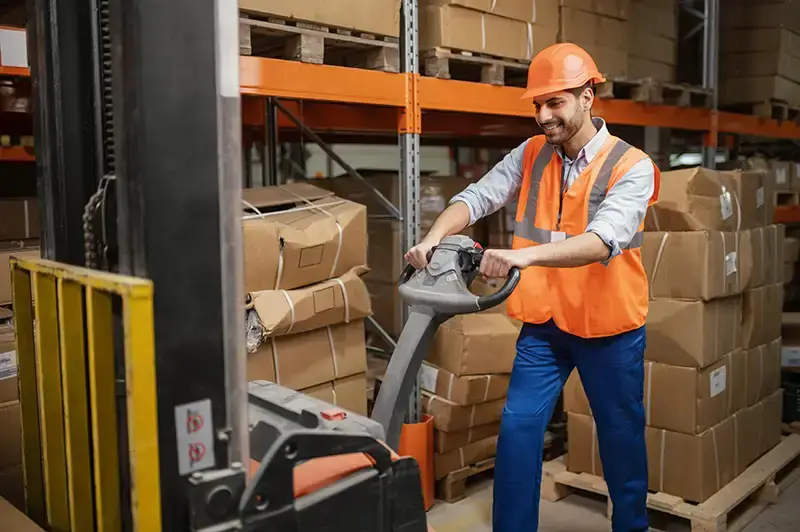In today’s fast-paced world, warehouses are constantly looking for ways to increase efficiency and productivity. While many warehouses have turned to automated equipment, power and manual pallet stackers still play a crucial role in the day-to-day operations. In this article, we will discuss why these products are essential in every warehouse and how they can benefit your business.
Difference between Pallet Load Stackers and Pallet Jacks
Firstly, what is the difference between a pallet or load stacker and a pallet jack? While both are used for handling palletized loads, the key distinction lies in the vertical lifting capability.
- Pallet jacks are primarily for horizontal movement.
- Pallet stackers are designed for both horizontal movement and vertical stacking.
The choice between the two depends on the specific material handling requirements of a given application.

What do Pallet Stackers do?
Before we dive into the benefits of manual and power stackers, let’s first define what they are. A pallet stacker, also known as a pallet truck, pallet jack, or pallet lifter, is a material handling device designed for lifting and moving pallets within a warehouse, distribution center, or other industrial settings. There are both manual and powered (electric or hydraulic) versions.
Key Features and Characteristics:
- Forks: Pallet stackers have forks that can be inserted into openings on a pallet. The forks are used to lift and lower the palletized load.
- Lifting Mechanism: In manual pallet stackers, the operator typically uses a pump handle to manually lift the forks. In powered pallet stackers, an electric or hydraulic motor is used for lifting.
- Capacity: Pallet stackers come in various capacities to handle different load weights. The capacity is the maximum weight that the stacker can lift and move safely.
- Adjustable Forks: Some pallet stackers have adjustable forks that can be widened or narrowed to accommodate pallets of various sizes.
- Maneuverability: Pallet stackers are designed for easy maneuverability, allowing operators to navigate through narrow aisles and tight spaces. They often have a compact design and can turn within a small radius.
- Powered vs. Manual: Manual pallet stackers are operated by physical effort from the operator, while powered pallet stackers use electric or hydraulic power for lifting and movement. Powered stackers are often preferred for larger loads or when frequent lifting is required.
- Applications: Pallet stackers are commonly used in warehouses, logistics centers, manufacturing facilities, and retail environments. They are essential for tasks such as loading and unloading trucks, transporting pallets within a facility, and stacking pallets in storage racks.

A Few Different Types of Pallet Stackers:
- Powered Pallet Stackers:
- Electric Pallet Stackers or Semi-Electric Pallet Stackers: These stackers are powered by electric motors. They are more suitable for frequent use and heavier loads. Electric pallet stackers often come with additional features such as powered steering for ease of maneuverability.
- Hydraulic Pallet Stackers: These stackers use hydraulic power to lift and lower loads. They can be manual or semi-electric, with manual propulsion and hydraulic lifting.
- Straddle Leg Stackers:
- Straddle Leg Stacker: These stackers have legs that straddle the pallet, allowing them to lift loads with bottom boards or skids. This design is useful for handling various pallet sizes.
- Reach Stackers:
- Reach Stacker: These stackers are designed to reach into pallet racking systems. They typically have telescoping forks and are capable of extending to reach multiple pallets deep into storage racks.
- Walkie Stacker or Walk-Behind Stackers:
- Walkie Stacker: These stackers are designed to be walked behind by an operator. They are maneuvered by the operator, making them suitable for applications with limited space.
- Rider Stackers:
- Rider Stacker: In contrast to walkie stackers, rider stackers allow the operator to ride on the equipment while operating it. This can increase efficiency and reduce operator fatigue, making them suitable for larger warehouses with longer travel distances.
- Straddle Reach Stackers:
- Straddle Reach Stacker: Combining features of both straddle stackers and reach stackers, these are designed to handle loads in rack systems with the added advantage of straddling the pallet.
What is the difference between a Manual Pallet Stacker and a Power Pallet Stacker?
A manual stacker is a type of material handling equipment that is used to lift and move pallets or other heavy loads. It is moved by a person pushing or pulling the stacker from place to place and operated by manual effort, typically using a pump handle to lift and lower the forks. They are more suitable for lighter loads.
A powered electric pallet stacker or hydraulic pallet stacker are very similar to the manual stackers, and while it is still operated by a human, the lift mechanism is electronically or semi-electronically powered by a built-in rechargable battery, some with fast charging, maintainance-free lithium batteries. They are more suitable for heavier loads. Electric pallet stackers often come with additional features such as powered steering for ease of maneuverability.
Versatility
One of the main benefits of stackers is their versatility. They can be used in a variety of settings, from small warehouses to large distribution centers. They are also suitable for a wide range of loads, including pallets, drums, and boxes. This versatility makes them an essential piece of equipment for any warehouse, as they can handle a variety of tasks and adapt to different environments.
Cost-Effective
Compared to automated equipment, manual stackers and pallet jacks are the most cost-effective. They require minimal maintenance and have a lower upfront cost, making them a budget-friendly option for warehouses. Additionally, they do not require any special training or certification to operate, saving you time and money on training programs.
Power stackers and electric pallet jacks are also much more cost-effective than automated equipment, and have the additional options of semi-electric or electric-powered lifting.
Space-Saving
The compact size is another benefit of pallet stackers, especially with narrow aisles or a lack of storage space for equipment. They are designed to be narrow and maneuverable, making them ideal for tight spaces in warehouses. This allows for more efficient use of space and can help increase storage capacity in your warehouse.
Easy to Use
Stackers are incredibly easy to use. They do not require any complex controls or programming, making them accessible to all warehouse employees. This ease of use also means that they can be quickly deployed to handle unexpected tasks or changes in the warehouse layout.
Increased Safety
Safety should always be a top priority in any warehouse. Pallet stackers offer a safer alternative to forklifts, as they do not require a license to operate and have a lower risk of accidents. Additionally, manual stackers have a lower risk of damaging products or equipment, reducing the potential for costly accidents.
In conclusion, manual stackers are essential in every warehouse due to their versatility, cost-effectiveness, space-saving design, ease of use, and increased safety. If you are looking to improve efficiency and productivity in your warehouse, consider investing in a manual stacker. Have you used manual stackers in your warehouse? Let us know in the comments.

